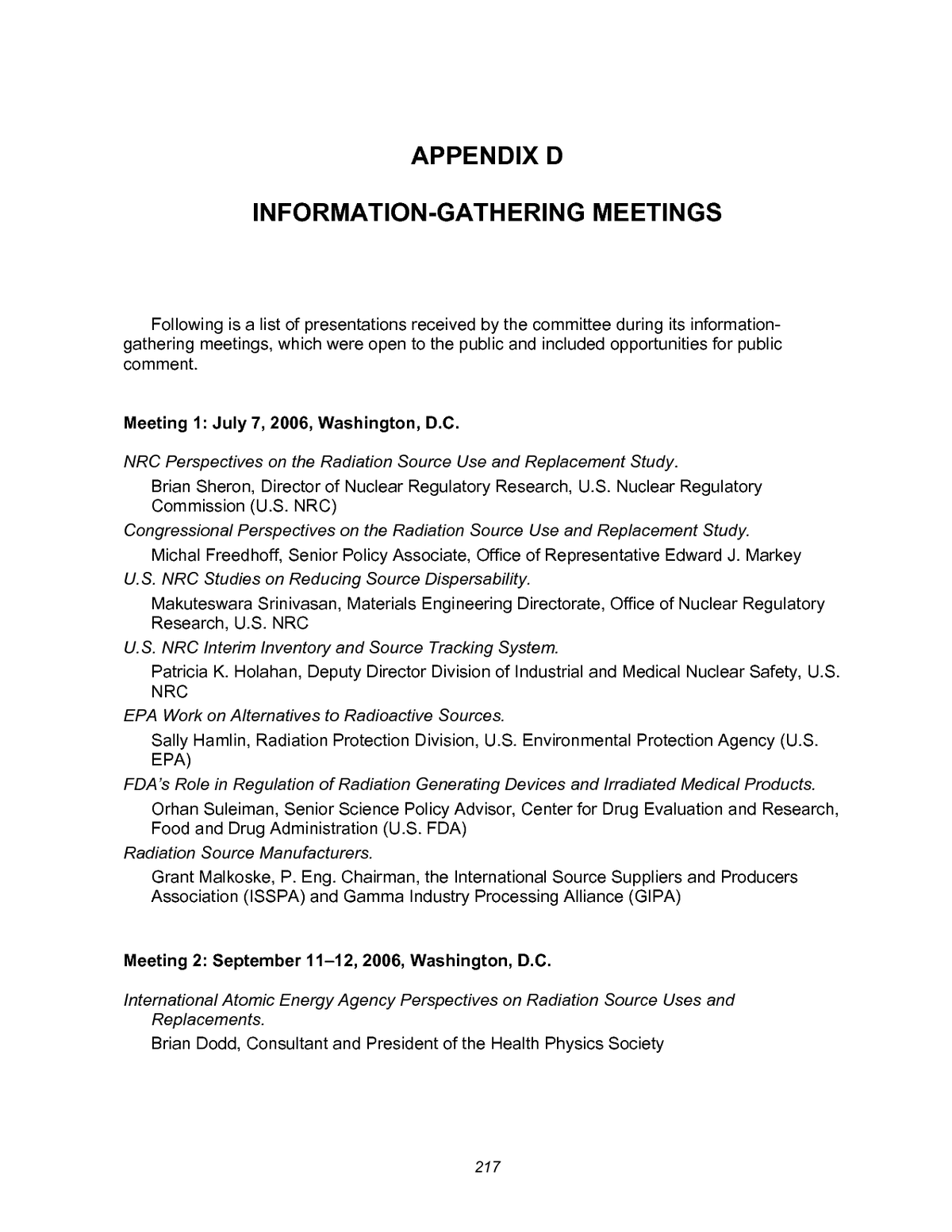Below is the uncorrected machine-read text of this chapter, intended to provide our own search engines and external engines with highly rich, chapter-representative searchable text of each book. Because it is UNCORRECTED material, please consider the following text as a useful but insufficient proxy for the authoritative book pages.
APPENDIX D INFORMATION-GATHERING MEETINGS Following is a list of presentations received by the committee during its information- gathering meetings, which were open to the public and included opportunities for public comment. Meeting 1: July 7, 2006, Washington, D.C. NRC Perspectives on the Radiation Source Use and Replacement Study. Brian Sheron, Director of Nuclear Regulatory Research, U.S. Nuclear Regulatory Commission (U.S. NRC) Congressional Perspectives on the Radiation Source Use and Replacement Study. Michal Freedhoff, Senior Policy Associate, Office of Representative Edward J. Markey U.S. NRC Studies on Reducing Source Dispersability. Makuteswara Srinivasan, Materials Engineering Directorate, Office of Nuclear Regulatory Research, U.S. NRC U.S. NRC Interim Inventory and Source Tracking System. Patricia K. Holahan, Deputy Director Division of Industrial and Medical Nuclear Safety, U.S. NRC EPA Work on Alternatives to Radioactive Sources. Sally Hamlin, Radiation Protection Division, U.S. Environmental Protection Agency (U.S. EPA) FDAâs Role in Regulation of Radiation Generating Devices and Irradiated Medical Products. Orhan Suleiman, Senior Science Policy Advisor, Center for Drug Evaluation and Research, Food and Drug Administration (U.S. FDA) Radiation Source Manufacturers. Grant Malkoske, P. Eng. Chairman, the International Source Suppliers and Producers Association (ISSPA) and Gamma Industry Processing Alliance (GIPA) Meeting 2: September 11â12, 2006, Washington, D.C. International Atomic Energy Agency Perspectives on Radiation Source Uses and Replacements. Brian Dodd, Consultant and President of the Health Physics Society 217
218 RADIATION SOURCE USE AND REPLACEMENT Interagency Report to Congress on Radiation Source Security, Nuclear Regulatory Commission. Merri Horn, Senior Project Manager, Officer of Nuclear Material Safety and Safeguards, U.S. NRC Recommendations and Alternative Technologies to IAEA Category 1 and 2 Radiation Sources Alternative: Technology Subgroup Radiation Source Protection and Security Task Force. Tony Huffert (U.S. NRC), for the Interagency Task Force Subgroup on Alternative Technologies Panel Discussion of the Alternatives Subgroup for the Report to Congress. Tony Huffert, U.S. NRC Constance Rosser, U.S. FDA Sally Hamlin, U.S. EPA Ruth Watkins and Joel Rabovsky, U.S. DOE Kirsten Cutler and Brendan Plapp, U.S. State Department Perspectives from the States. Pearce OâKelley, Conference of Radiation Control Program Directors Barbara Hamrick, Organization of Agreement States Meeting 3: October 26â28, 2006, Houston, Texas Oil-Well Logging. Allen Gilchrist, Baker Hues Practical Considerations in Current Applications for Nondestructive Testing. Michael Creech, Vice President, Acuren Inspection Inc. Radiography Methods, Equipment, and Current Practices. R. D. âDonnyâ Dicharry, President, Source Production & Equipment Co., Inc. Radiosurgery. Chuck Vecoli, Senior Business Marketing Manager, Elekta, Inc. Comparison of Radiation Processing Technologies. Mark A. Smith, CHP Vice President, Radiation Services, Sterigenics International Capabilities of Techniques and R&D for Nondestructive Testing. Glenn Light, Southwest Research Institute, and Grady Legleder, IHI Southwest Technologies Industrial Accelerators and X-ray Tubes; Capabilities and Limitations as a Replacement to Isotropic Sources. Lester Boeh, Varian Medical Systems Houston Medical Center tour. Karl Prado, Patricia Eifel, Benjamin Lichtiger, Shiao Woo, Michael Gillin, Ann Lawyer, Radhe Mohan, Ray Meyn, Jay Poston, Peggy Tinkey, and Almon Shiu of MD Anderson Cancer Center Otto Zeck of Memorial Hermann Hospital National Center for Electron Beam Food Research Facility Tour. Mickey Speakmon and Les Braby, National Center for Electron Beam Food Research, Texas A&M University, College Station
INFORMATION-GATHERING MEETINGS 219 Meeting 4: December 8â9, 2006, Washington, D.C. J. L. Shepherd and Associates on Cesium Chloride and Irradiators. Wayne Norwood, for J.L. Shepherd and Associates Rad Source Technologies, Inc. on X-Ray Blood Irradiator. Randol Kirk, President, Rad Source Technologies, Inc. ViewRay IGRT with MRI and Co-60 Sources. Jim Dempsey, CSO, ViewRay, Inc. Nordion-NOMIS CT-Co-60 IMRT Venture, X-Ray Blood Irradiator. Mark Vist, MDS-Nordion IBA Industrial X-Ray and E-Beam Irradiation Devices. Marshall Cleland, Technical Advisor, RDI, Member of the IBA Group Meeting 5: February 1â2, 2007, Irvine, California U.S. Offsite Source Recovery Program. Mike Pearson, Los Alamos National Laboratory Discussion on Cesium Chloride, Cesium Glass, and Cobalt Irradiators. J. L. Shepherd, J.L. Shepherd and Associates




